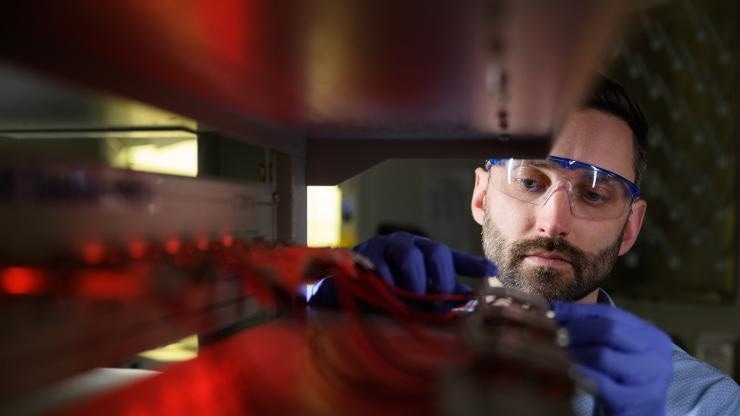Jul 1 2019
Solid-state batteries can be said to be a new kind of battery design that utilizes all solid components.
 Matthew McDowell, an assistant professor in the George W. Woodruff School of Mechanical Engineering and the School of Materials Science and Engineering, examines batteries in a cycling station. (Image credit: Rob Felt)
Matthew McDowell, an assistant professor in the George W. Woodruff School of Mechanical Engineering and the School of Materials Science and Engineering, examines batteries in a cycling station. (Image credit: Rob Felt)
Now, in the past few years, these batteries have attracted a great deal of attention owing to their ability to hold relatively large amounts of energy and, at the same time, they also avoid the safety issues associated with their liquid-based counterparts.
However, it is not easy to build a solid-state battery that lasts for a long time. Now, researchers at the Georgia Institute of Technology (George Tech) have utilized X-ray computed tomography (CT) to observe in real time how cracks develop close to the borders of the interfaces between materials present in the batteries. These findings could allow scientists to look for new ways to enhance the energy storage devices.
Solid-state batteries could be safer than lithium-ion batteries and potentially hold more energy, which would be ideal for electric vehicles and even electric aircraft. Technologically, it’s a very fast moving field, and there are a lot of companies interested in this.
Matthew McDowell, Assistant Professor, George W. Woodruff School of Mechanical Engineering and School of Materials Science and Engineering, George Tech
In a normal lithium-ion battery, energy is discharged while lithium ions are transferring between a pair of electrodes—an anode and a cathode—via a liquid electrolyte.
The study was sponsored by the National Science Foundation and was published in the journal ACS Energy Letters on June 4th, 2019. For the study, the researchers constructed a new solid-state battery, wherein a solid ceramic disc was packed closely between two pieces of solid lithium. The typical liquid electrolyte was replaced by the ceramic disc.
Figuring out how to make these solid pieces fit together and behave well over long periods of time is the challenge. We’re working on how to engineer these interfaces between these solid pieces to make them last as long as possible.
Matthew McDowell, Assistant Professor, George W. Woodruff School of Mechanical Engineering and School of Materials Science and Engineering, George Tech
In association with Christopher Saldana, an expert in X-ray imaging and an assistant professor in the George W. Woodruff School of Mechanical Engineering at Georgia Tech, the scientists initially placed the solid-state battery under an X-ray microscope and then charged and discharged it, watching for signs of physical changes that indicate degradation. Subsequently, over the course of several days, a web-like pattern of cracks gradually formed all through the disc.
Those cracks indicated the issue and form alongside the growth of an interphase layer between the solid electrolyte and lithium metal. This fracture that occurs during cycling induces resistance to the flow of ions, observed the investigators.
“These are unwanted chemical reactions that occur at the interfaces,” McDowell stated. “People have generally assumed that these chemical reactions are the cause of the degradation of the cell. But what we learned by doing this imaging is that in this particular material, it’s not the chemical reactions themselves that are bad—they don’t affect the performance of the battery. What’s bad is that the cell fractures, and that destroys the performance of the cell.”
One of the first steps would be to solve the fracturing problem. Doing so may reveal the capacity of solid-state batteries, including their high-energy density. The researchers observed that the deterioration may have an impact on other kinds of solid-state batteries, and therefore the findings can possibly lead to the design of more long-lasting interfaces.
In normal lithium-ion batteries, the materials we use define how much energy we can store. Pure lithium can hold the most, but it doesn’t work well with liquid electrolyte. But if you could use solid lithium with a solid electrolyte, that would be the holy grail of energy density.
Matthew McDowell, Assistant Professor, George W. Woodruff School of Mechanical Engineering and School of Materials Science and Engineering, George Tech
This study is based on work supported by the National Science Foundation under Grant Nos. DMR-1652471, CMMI-1825640/1254818, ECCS-1542174, and CMMI-1825132.
Unlocking the potential of solid-state batteries
Georgia Tech researchers are looking into a new battery design that uses all solid materials that could offer higher safety and more energy density than traditional batteries. (video credit: Josh Brown, Rob Felt)